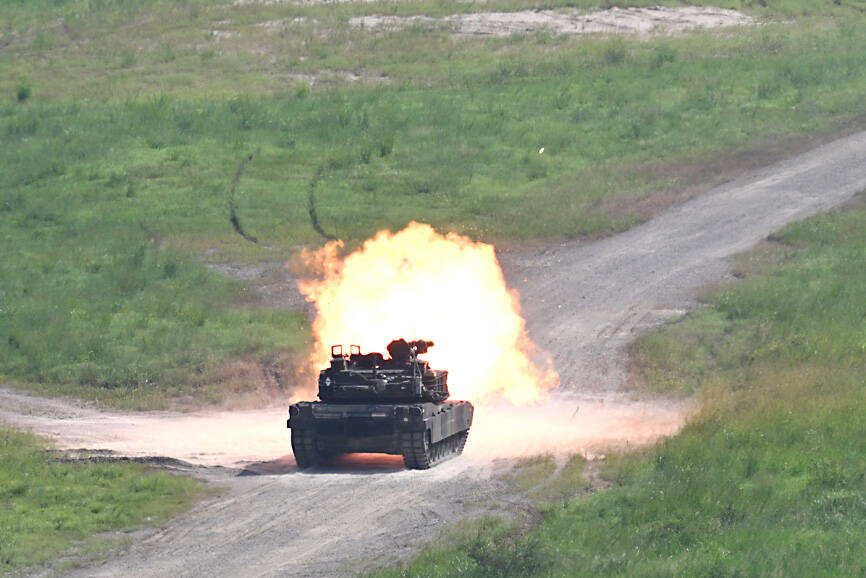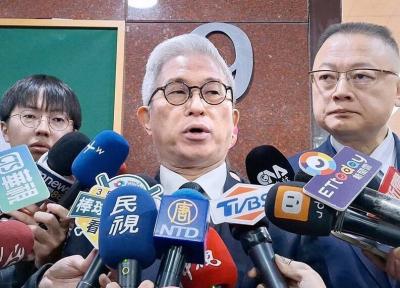The M1A2T tanks that Taiwan expects to take delivery of later this month are to spark a “qualitative leap” in the operational capabilities of the nation’s armored forces, a retired general told the Liberty Times (sister paper of the Taipei Times) in an interview published yesterday.
On Tuesday, the army in a statement said it anticipates receiving the first batch of 38 M1A2T Abrams main battle tanks from the US, out of 108 tanks ordered, in the coming weeks.
The M1 Abrams main battle tank is a generation ahead of the Taiwanese army’s US-made M60A3 and indigenously developed CM11 tanks, which have designs dating to the 1980s, retired major general Kuo Li-sheng (郭力升) said.

Photo: AFP
“Fielding the M1A2T would not only represent an increase to numerical strength, but constitute a qualitative leap,” he said.
The M1A2T is Taiwan’s best option for obtaining new tanks, as the nation is prevented from seeking an alternative source of arms, and developing an indigenous system is prohibitively expensive and time-consuming, he said.
The army has always planned to acquire M1 Abrams main battle tanks, AH-64 Apache attack helicopters and M109A6 self-propelled howitzers, a decision made in the 1990s, when the service began fielding the M60A3 and CM-11, he said.
These systems’ acquisition would mark a goalpost in the army’s effort to enhance its three-dimensional warfare capabilities, mechanization and digitization, Kuo said.
The more modern M1A2T is superior to legacy systems in firepower, mobility and protection, performance categories that make up the metrics for assessing a tank’s effectiveness, he said.
With respect to firepower, the M1A2T is more advanced than the tanks in Taiwanese service by multiple generations, Kuo said.
Most significantly, the M1A2T demonstrates “impressive target acquisition capabilities” due to being equipped with a 40-power magnification thermal imager capable of distinguishing a human face at 2km, he said.
M60A3 and CM-11 tanks are equipped with far less capable devices that have 6 to 8-power magnification, Kuo said.
An armored unit equipped with M1A2T tanks can fight with better target identification, target distribution and a lower risk of friendly fire, he added.
The M1A2T’s main armament, the 120mm smoothbore gun, boasts an effective range of more than 2km, compared with the 1.2km effective range of the M68A1’s 105mm rifled gun utilized in Taiwanese tanks, he said.
In addition, the M60A3 and CM-11 lack a muzzle reference sensor to correct the effect of thermal expansion on the gun barrel, causing a loss in accuracy after a string of seven shots, Kuo said.
The M1A2T, which is equipped with this feature, can fire every round as accurately as the first shot, he said.
The M1 Abrams family of tanks utilizes a gas turbine as their power plant, enabling a maximum speed of about 70kph, while Taiwanese army tank crews almost never drive at speeds exceeding 40kph, Kuo said.
The M60A3 and CM-11 use the chassis of the M60 Patton family of tanks, which was once excellent, but has since become old and worn out, he said.
Although Kuo did not elaborate on the M1A2T’s armor, publicly available information showed that composite armor — a design deemed significantly more effective than the steel plating of M60A3 and CM-11 — is utilized to protect the tank.
The army’s plan over the coming year is likely to use the M1A2T to replace obsolescent tanks in existing units instead of creating new armored formations, he said, adding that northern Taiwan would probably be prioritized.
The greater Taipei area is jointly defended by the army, military police and marines with about 200 main battle tanks altogether, he said, adding that replacing half that number with modern tanks would greatly strengthen defenses.
The modern tanks “would have a huge impact on the defense of our lynchpin and strategic center of gravity, as well as the conduct of combined ground defense operations as a whole,” Kuo said.
Taiwan would be highly likely to place additional orders of M1A2T tanks, as 108 vehicles represent a relatively small number compared to the nation’s fleet of nearly 1,000 tanks, Kuo said.
The Taiwan-US military exchange enabling the transfer of the tanks similarly signaled an unprecedented level of cooperation between the two nation’s armed forces, he said.
Assessments by the Taiwanese and US armed forces showed that introducing M1A2T tanks to the nation would significantly improve joint defense capabilities, Kuo said.

Taiwan is to commence mass production of the Tien Kung (天弓, “Sky Bow”) III, IV and V missiles by the second quarter of this year if the legislature approves the government’s NT$1.25 trillion (US$39.78 billion) special defense budget, an official said yesterday. Commenting on condition of anonymity, a defense official with knowledge of the matter said that the advanced systems are expected to provide crucial capabilities against ballistic and cruise missiles for the proposed “T-Dome,” an advanced, multi-layered air defense network. The Tien Kung III is an air defense missile with a maximum interception altitude of 35km. The Tien Kung IV and V

The disruption of 941 flights in and out of Taiwan due to China’s large-scale military exercises was no accident, but rather the result of a “quasi-blockade” used to simulate creating the air and sea routes needed for an amphibious landing, a military expert said. The disruptions occurred on Tuesday and lasted about 10 hours as China conducted live-fire drills in the Taiwan Strait. The Civil Aviation Administration (CAA) said the exercises affected 857 international flights and 84 domestic flights, affecting more than 100,000 travelers. Su Tzu-yun (蘇紫雲), a research fellow at the government-sponsored Institute for National Defense and Security Research, said the air

A strong continental cold air mass is to bring pollutants to Taiwan from tomorrow, the Ministry of Environment said today, as it issued an “orange” air quality alert for most of the country. All of Taiwan except for Hualien and Taitung counties is to be under an “orange” air quality alert tomorrow, indicating air quality that is unhealthy for sensitive groups. In China, areas from Shandong to Shanghai have been enveloped in haze since Saturday, the ministry said in a news release. Yesterday, hourly concentrations of PM2.5 in these areas ranged from 65 to 160 micrograms per cubic meter (mg/m³), and pollutants were

Taiwan’s armed forces have established response protocols for a wide range of sudden contingencies, including the “Wan Chun Plan” to protect the head of state, the Ministry of Defense (MND) said today. After US President Donald Trump on Saturday launched a series of airstrikes in Venezuela and kidnapped Venezuelan President Nicolas Maduro, concerns have been raised as to whether China would launch a similar “decapitation strike” on Taiwan. The armed forces regularly coordinate with relevant agencies and practice drills to ensure preparedness for a wide range of scenarios, Vice Minister of National Defense Hsu Szu-chien (徐斯儉) told reporters before a